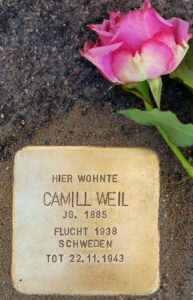Camill WEIL was born in Prague (then in Austria-Hungary) Czechoslovakia after 1918 and now in the Czech Republic) on March 2, 1885. He was the third of the seven children of the Jewish couple Ludmilla Knina Weil and David Weil, a mercantile family. His parents’ Prague grave can be found in the new Jewish cemetery in the Straschnitz (Strašnice) neighborhood.
Camill WEIL got a degree in civil engineering from the Prague Institute of Technology and then worked for the Imperial and Royal (K&k) Austrian State Railways. From 1910 on he was in the operations management of the Arlberg-Bahn, in Bludenz and St. Anton am Arlberg in the western part of Austria (in the states of Vorarlberg and Tyrol).
Then, in the 1920s he was the construction supervisor for the Austrian Federal Railways (ÖBB) in Zell am See (about 50 miles south of the city of Salzburg) and after 1929 he was the chief construction supervisor in Salzburg.
He got married in 1909 and had two daughters who were born in Bludenz, Gerda and Ilse. After his divorce from his first wife, the Jewish Hilde Klein Weil from Prague, he married a Catholic woman named Therese in Salzburg’s municipal offices (in a civil ceremony for an interfaith marriage). The family lived at 8 Josef-Mayburger-Kai until November 1938.
All of the Jewish men still living in Salzburg were arrested by the Gestapo during the pogrom night of November 9-10, 1938 (the so-called »night of broken glass«): the oldest of them were deported to Vienna after a few days while those born between 1883 and 1914, including Camill WEIL, were sent to the Dachau concentration camp on November 12, 1938.
Camill WEIL was registered in Dachau as Jewish »protective custody« prisoner number 23536, but he was released that same month on the 28th on condition that he should leave the Third Reich promptly.
The police registration files of the city of Salzburg indicate that the WEIL family had to turn their lovely apartment on the Josef-Mayburger-Kai over to a Nazi press functionary while they lived with some friends for a year before the registration files recorded their move to Stockholm on December 6, 1939.
It isn’t clear if any religious or political refugee agency helped the family to get to Sweden. Sweden took in 700 to 1,000 refugees from Austria and interned them for some time before letting them live freely in Sweden.
Little is known about the lives of the Weil family in Sweden; except that Camill WEIL died in Stockholm at age 58 on June 23, 1943 and that his mistreatment in Dachau may have contributed to his early death.
We do know what happened before his death to those of his relatives who found themselves living under Nazi rule in the »Protectorate of Bohemia and Moravia« after March 1939.
On April 28, 1942 his six siblings: Irma, Otto, Emil, Franz, Martha and Josef were sent with their families from Prague to the Theresienstadt concentration camp and a few days later they were sent on to Zamosc (about 50 miles south-east of Lublin Poland) on April 30, 1942 – where they were all murdered.
Recent research has discovered that Camill WEIL’s younger daughter Ilse had emigrated to Sweden as early as 1937, where she married a Swede named Arne Karlsson in Stockholm and they had a son named Tom.
We have also learned that Camill WEIL’s older daughter Gerda (Gertrud) fled from the Nazi regime to England and that her birth mother Hilde Klein Weil, who had remarried, survived the Theresienstadt concentration camp as Hilde Reif. Sometime around 1948 Gerda (Gertrud) left England and moved to Sweden with her mother Hilde Reif.
Camill WEIL’s second wife Therese left Sweden and returned to Salzburg, where she died in 1970.
Sources
- Salzburg city and state archives
- Dachau Concentration Camp Memorial
- National Archives in Prague
- Yad Vashem
Translation: Stan Nadel
Stumbling Stone
Laid 18.08.2016 at Salzburg, Josef-Mayburger-Kai 8


